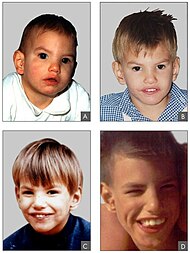Cri du chat syndrome (French for cry or call of the cat referring to the specific mew-like cry of affected children), also known as cri-du-chat syndrome, chromosome 5p deletion syndrome, 5p minus syndrome or Lejeune’s syndrome, is a rare genetic disorder due to a missing portion of chromosome 5. It was first described by Jérôme Lejeune in 1963. The condition affects an estimated 1 in 20,000 to 50,000 live births. The disorder is found in people of all ethnic backgrounds and is more common in females by a 4:3 ratio.
| Cri du chat or Cri-du -chat | |
| Facial features of a patient with Cri du Chat syndrome at age of 8 months (A), 2 years (B), 4 years (C) and 9 years 6/12 (D) |
Signs and symptoms
The syndrome gets its name from the characteristic cry of infants born with the disorder. The infant sounds just like a meowing kitten, due to problems with the larynx and nervous system. This cry identifies the syndrome. About 1/3 of children lose the cry by age 2. Other symptoms of cri du chat syndrome may include:
- feeding problems because of difficulty swallowing and sucking,
- low birth weight and poor growth,
- severe cognitive, speech, and motor delays,
- behavioral problems such as hyperactivity, aggression, tantrums, and repetitive movements,
- unusual facial features which may change over time.
- excessive dribbling.
- constipation.
In addition, common findings include hypotonia, microcephaly, growth retardation, a round face with full cheeks, hypertelorism, epicanthal folds, down-slanting palpebral fissures, strabismus, flat nasal bridge, down-turned mouth, micrognathia, low-set ears, short fingers, single palmar creases, and cardiac defects (eg, ventricular septal defect [VSD], atrial septal defect [ASD], patent ductus arteriosus [PDA], tetralogy of Fallot). The Cri du chat affected people are fertile and can reproduce.
Less frequently encountered findings include cleft lip and palate, preauricular tags and fistulas, thymic dysplasia, gut malrotation, megacolon, inguinal hernia, dislocated hips, cryptorchidism, hypospadias, rare renal malformations (eg, horseshoe kidneys, renal ectopia or agenesis, hydronephrosis), clinodactyly of the fifth fingers, talipes equinovarus, pes planus, syndactyly of the second and third fingers and toes, oligosyndactyly, and hyperextensible joints.
Late childhood and adolescence findings include severe mental retardation, microcephaly, coarsening of facial features, prominent supraorbital ridges, deep-set eyes, hypoplastic nasal bridge, severe malocclusion, and scoliosis.
Affected females reach puberty, develop secondary sex characteristics, and menstruate at the usual time. The genital tract is usually normal in females except for a report of a bicornuate uterus.
In males, testes are often small, but spermatogenesis is thought to be normal.
Dermatoglyphics: Transverse flexion creases, distal axial triradius, increased whorls and arches on digits, single line on the palm of the hand (simian crease).
Genetics
Cri du chat syndrome is due to a partial deletion of the short arm of chromosome number 5. Approximately 80% of cases results from a sporadic de novo deletion, while about 10-15% are due to unequal segregation of a parental balanced translocation where the 5p monosomy is often accompanied by a trisomic portion of the genome. The phenotypes in these individuals may be more severe than in those with isolated monosomy of 5p because of this additional trisomic portion of the genome. Most cases involve terminal deletions with 30-60% loss of 5p material. Fewer than 10% of cases have other rare cytogenetic aberrations (eg, interstitial deletions, mosaicisms, rings and de novo translocations). The deleted chromosome 5 is paternal in origin in about 80% of the cases.
Loss of a small region in band 5p15.2 (cri du chat critical region) correlates with all the clinical features of the syndrome with the exception of the catlike cry, which maps to band 5p15.3 (catlike critical region). The results suggest that 2 noncontiguous critical regions contain genes involved in this condition's etiology. Two genes, Semaphorine F (SEMA5A) and [delta catenin] (CTNND2), which have been mapped to the critical regions are potentially involved in cerebral development and its deletion may be associated in CdCS patients. Also the deletion of the telomerase reverse transcriptase (hTERT) gene localized in 5p15.33 should contribute to the phenotypic changes in CdCS.
Although the size of the deletion varies, a deletion at region 5p15.3 is responsible for the unique cry and deletion at the critical region of 5p15.2 for the other features. The deletion is of paternal origin in about 80 % of cases in which the syndrome is de novo.
Diagnosis
Diagnosis is based on the distinctive cry and accompanying physical problems. Genetic counseling and genetic testing may be offered to families with individuals who have cri du chat syndrome.












No comments:
Post a Comment